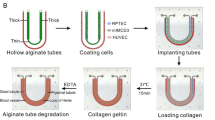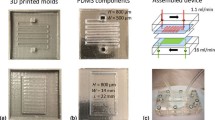Abstract
We report the fabrication and function evaluation of multi-layer biochip dialyzer. Such device may potentially be applied to the wearable hemodialysis systems. By merging the advantages of microfluidic chip technology with cell engineering, both functions of glomerular filtration and renal tubule physiological activity are integrated in the same device. This device is designed into a laminated structure, in which the chip number of the superimposed layer can be arbitrarily tailored in accordance with the requirements of dialysis capacity. We propose that such structure can overcome the obstacles of large size and detached structure of the traditional hollow fiber dialyzer. To construct this multilayer biochips dialyzer, two types of dialyzer device with two-layered and six-layered chips are assembled, respectively. Cell adhesion and proliferation on three different dialysis membrane materials under static and dynamic conditions are investigated and compared. The filtration capability, re-absorption function and excrete ammonia function of the resulting multi-layer biochip dialyzer are evaluated. The results reveal that the constructed device can perform higher filtration efficiency and also play a role of renal tubule. This methodology may be useful in developing “scaling down” artificial kidneys that can act as wearable or even implantable hemodialysis systems.








Similar content being viewed by others
References
N. Ferrell, R.R. Desai, A.J. Fleischman et al., A microfluidic bioreactor with integrated transepithelial electrical resistance (TEER) measurement electrodes for evaluation of renal epithelial cells. Biotech. Bioeng. 107(4), 707–716 (2010)
N. Ferrell, K.B. Ricci, J. Groszek et al., Albumin handling by renal tubular epithelial cells in a microfluidic bioreactor. Biotech. Bioeng. 109(3), 797–803 (2012)
X.F. Gao, Y. Tanaka, Y. Sugii et al., Basic structure and cell culture condition of a bioartificial renal tubule on chip towards a cell-based separation microdevice. Anal. Sci. 27, 907–912 (2011)
Y. Gu, N. Miki. Microfilter Fabricated with PDMS and PES Membrane Applicable for Implantable Artificial Kidney, Proceedings of the 2nd IEEE International Conference on Nano/Micro Engineered and Molecular Systems, Bangkok, Thailand, 16–19 January 2007
Y. Gu, N. Miki, Multilayered microfilter using a nanoporous PES membrane and applicable as the dialyzer of a wearable artificial kidney. J. Micromech. Microeng. 19, 065031 (2009). 8pp
A.C. Guyton, J.E. Hall, Urine Formation by the Kidneys, in Human Physiology and Mechanisms of Disease (WB Saunders Company, Philadelphia, 1997), pp. 223–235
M. Horie, K. Nishio, K. Fujita et al., Cellular responses by stable and uniform ultrafine titanium dioxide particles in culture-medium dispersions when secondary particle size was 100 nm or less. Toxicol. in Vitro Int. J. Publ. Assoc. BIBRA 24(6), 1629–1638 (2010)
W.H. Hőrl, K.M. Koch, R.M. Lindsay, et al., Replacement of Renal Function by Dialysis. (Kluwer Academic Publishers, 2004), 313.
D. Huh, B.D. Matthews, A. Mammoto et al., Reconstituting organ-level lung functions on a chip. Science 328, 1662–1668 (2010)
H.D. Humes, The bioartificial renal tubule: prospects to improve supportive care in acute renal failure. Ren. Fail. 18, 405–408 (1996)
H.D. Humes, Stem cells: the next therapeutic frontier. Trans. Am. Clin. Climatol. Assoc. 116, 167–184 (2005)
H.D. Humes, S.M. Mackay, A.J. Funke et al., Tissue engineering of the bioartificial renal tubule assist device: in vitro transport and metabolic characteristics. Kidney Int. 55, 2502–2514 (1999a)
H.D. Humes, D.A. Buffington, S.M. Mackay et al., Replacement of renal function in uremic animals with a tissue-engineered kidney. Nat. Biotechnol. 17, 451–455 (1999b)
H.D. Humes, W.F. Weitzel, R.H. Bartlett et al., Initial clinical results of the bioartificial kidney containing human cells in ICU patients with acute renal failure. Kidney Int. 66, 1578 (2004)
P.J. Hung, P.J. Lee, P. Sabounchi et al., Continuous perfusion microfluidic cell culture array for high-throughput cell-based assays. Biotechnol. Bioeng. 89(1), 1–8 (2005)
D. Janasek, J. Franzke, A. Manz, Scaling and the design of miniaturized chemical-analysis systems. Nature 442, 374–380 (2006)
K.J. Jang, K.Y. Suh, A multi-layer microfluidic device for efficient culture and analysis of renal tubular cells. Lab Chip 10, 36–42 (2010)
K.J. Jang, H.S. Cho, D.H. Kang et al., Fluid-shear-stress-induced translocation of aquaporin-2 and reorganization of actin cytoskeleton in renal tubular epithelial cells. Integr. Biol. 3, 134–141 (2011)
S. Joffy, M.H. Rosner, Natriuretic peptides in ESRD. Am. J. Kidney Dis 46(1), 1–10 (2005)
M.R. Kaazempur-Mofrad, J.P. Vacanti, N.J. Krebs, et al. A MEMS-based renal replacement system. Solid-State Sensor. 67–70 (2004).
D.S. Kim, S.H. Lee, C.H. Ahn et al., Disposable integrated microfluidic biochip for blood typing by plastic microinjection moulding. Lab Chip 6, 794–802 (2006)
K.H. Lee, D.J. Kim, B.G. Min et al., Polymeric nanofiber web-based artificial renal microfluidic chip. Biomed. Microdevices 9, 435–442 (2007)
A.R. Nissenson, Bottom-up nanotechnology: the human nephron filter. Semin. Dial. 22(6), 661–664 (2009)
A.R. Nissenson, C. Ronco, G. Pergamit et al., The human nephron filter: toward a continuously functioning, implantable artificial nephron system. Blood Purif. 23, 269–274 (2005a)
A.R. Nissenson, C. Ronco, G. Pergamit et al., Continuously functioning artificial nephron system: the promise of nanotechnology. Hemodial. Int. 9, 210–217 (2005b)
N. Ozgen, M. Terashima, T. Aung et al., Evaluation of long-term transport ability of a bioartificial renal tubule device using LLC-PK1 cells. Nephrol. Dial. Transplant. 19, 2198–2207 (2004)
K.C. Popat, L. Leoni, C.A. Grimes et al., Influence of engineered titania nanotubular surfaces on bone cells. Biomaterials 28, 3188–3197 (2007)
M. Sato, T. Ohashi, Biorheological views of endothelial cell responses to mechanical stimuli. Biorheology 42(6), 421–441 (2005)
Y. Sekiguchi, T. Dohi, H. Funakubo. Application of NiTi shape memory alloy to use a micro-pump for portable or wearable artificial kidney system. Meeting of the Society for Biomaterials. 592, (1982).
J.H. Seo, D.J. Kim, S.U. Son et al., Separation of blood cells and plasma in microchannel. Solid-State Sensors Actuators Microsyst. 2, 1684–1687 (2005)
B.S. Smith, S. Yoriya, L. Grissom et al., Hemocompatibility of titania nanotube arrays. J. Biomed. Mater. Res. A 95A(2), 350–360 (2010)
S. Song, A.K. Singh, T.J. Shepodd et al., Microchip dialysis of proteins using in situ photopatterned nanoporous polymer membranes. Anal. Chem. 76(8), 2367–2373 (2004)
M. Tanaka, A. Takayama, E. Ito et al., Effect of pore size of self-organized honeycomb-patterned polymer films on spreading, focal adhesion, proliferation, and function of endothelial cells. J. Nanosci. Nanotechnol. 7(3), 763–772 (2007)
G.M. Whitesides, The origins and the future of microfluidics. Nature 442, 368–373 (2006)
P. Yager, T. Edwards, E. Fu et al., Microfluidic diagnostic technologies for global public health. Nature 442, 412–418 (2006)
S.H. Ye, J. Watanabe, M. Takai et al., Design of functional hollow fiber membranes modified with phospholipid polymers for application in total hemopurification system. Biomaterials 26(24), 5032–5041 (2005)
Acknowledgments
This work was financed by the National Natural Science Foundation of China (21173090 and 30970717), and the Special Fund for Strategic Emerging Industry Development of Shenzhen (JCYJ20120618100557119). Technical assistance from the Analytical and Testing Center of HUST is gratefully acknowledged.
Author information
Authors and Affiliations
Corresponding author
Rights and permissions
About this article
Cite this article
Zhu, W., Li, J. & Liu, J. The cell engineering construction and function evaluation of multi-layer biochip dialyzer. Biomed Microdevices 15, 781–791 (2013). https://doi.org/10.1007/s10544-013-9764-x
Published:
Issue Date:
DOI: https://doi.org/10.1007/s10544-013-9764-x




